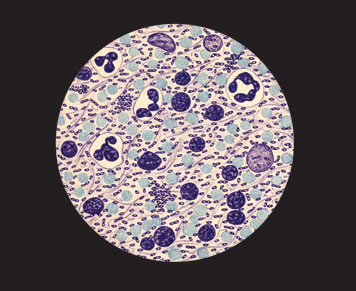
"Bubonic Plague," in Albert Fournier, Atlas de Bactériologie, ca. 1910. (Collection: Winterhouse)
I took part in the recent Eye magazine debate in London on the relationship between design and marketing. Also on the panel was a creative director from one of the big international branding agencies. He talked about design in a way that I found barely comprehensible. He used phrases like "driving customer revenues." He made design sound like something you squirt from an aerosol can. My blood thinned. Everything he said confirmed my distaste for the corporatization of design.
And yet, as I listened, I found myself if not exactly agreeing with him, then at least seeing that he had a point of view. He spoke in a modest and reasonable way. It was obvious that he regarded his approach to design as thoroughly professional and utterly unexceptional. Perhaps he was right and I was wrong? Perhaps it is dumb of me to believe that the only design worth bothering about is design born out of a mixture of personal enquiry and intelligent intuition? As these thoughts fizzed in my head, I realized I was suffering from the designer's virus: empathy.
Empathy gives us the ability to see the other person's point of view. And when you think about it, there's no more valuable skill for the working graphic designer than the capacity to see a client's point of view. The objectivity that designers derive from an empathetic nature is invaluable.
I discovered early in my working life that I was nearly always able to sense what clients wanted. I could do it even when they weren't sure themselves what they wanted. By a sort of automatic psychological profiling, I found that I could intuit what would make them happy. Over the years this sixth sense grew. It sometimes became difficult when dealing with groups of people, yet I found that I could usually locate a collective desire.
I knew what the bastards wanted and I gave it to them. But as I developed my own philosophy of design, my ability to know what a client wanted started to become a burden. Sometimes what they wanted wasn't what I wanted; sometimes what they wanted was just plain bad. Wrong, even. Gradually I realized that I'd produce better work if I didn't have so much empathy shrouding my thinking.
It's a favorite pastime amongst observers of the design scene to divide designers into opposing camps. In an interview with Steven Heller, Massimo Vignelli defined two contrasting types of designer: "One is rooted in history and semiotics and problem solving. The other is more rooted in the liberal arts — painting, figurative arts, advertising, trends, and fashions. These are really two different avenues . . . one side is the structured side, the other is the emotional side." In his celebrated Eye article, "The Steamroller of Branding," Nick Bell suggested that designers could be classified as either "agents of neutrality" or "aesthetes of style."
Let me suggest another possibility: designers are either empathizers or egotists. Most of us are empathizers; we want to please our clients and we are happy to forgo some personal gratification in favour of giving them what they are expecting. But egotists are only interested in getting what they want: they have a fundamentalist certainty about themselves and their abilities. Their work is often better than the work of the empathisers.
I caught a glimpse of the non-empathetic approach recently when I interviewed the British illustrator Terry Dowling. Dowling is a cruelly neglected figure. A pioneer of radical illustration in the 1970s, his dark, chopped-up collages were a precursor of Punk style. He was also Vaughn Oliver's tutor, and has subsequently worked with Oliver on a number of projects. I pointed out that during his long career he'd hardly ever done any commercial work. "It might sound arrogant," he said, "but I will only work with clients who give me a totally free hand — and if they don't like what they see, they don't pay for it. I've done a number of significant jobs that have gone right the way through, and then been rejected. So I say, sorry but find somebody else, I don't want to be messed around."
Much as I admire this, I couldn't do it. My empathetic nature wouldn't allow me. I've sacked a few clients in my time, but I've persevered with countless others who deserved to be dumped. And the reason I persevered with them was because I could see their point of view even when they were behaving unreasonably. Empathy in design leads to harmony and professional accord, perhaps even to riches. It's an essential part of the job. But it's also responsible for lots of mediocrity and formulaic design solutions. And if you've got the empathy virus, there's no known cure.
